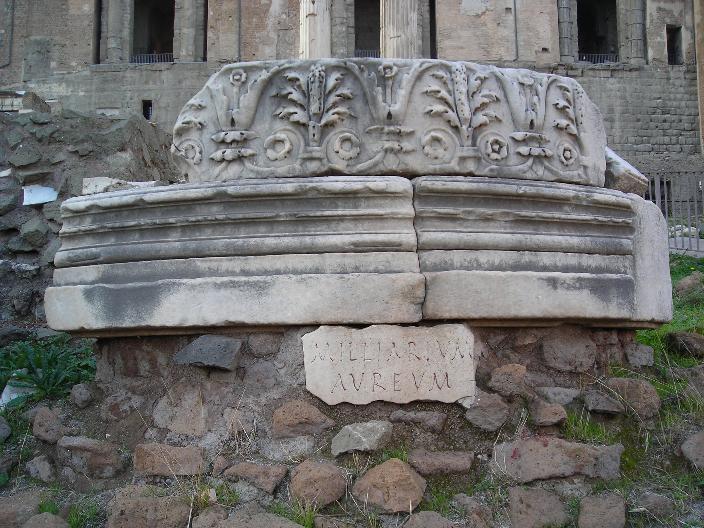Il sistema stradale romano già nei primi secoli della Res Publica correva lungo la penisola e consentiva agli eserciti consolari di spostarsi verso le prime province conquistate, come ad esempio la Sicilia e la Gallia Cisalpina. Al momento della massima espansione dell'Impero la rete viaria romana misurava oltre 80.000 chilometri, ripartiti fra 24 strade che si irradiavano da Roma verso l'Italia e altre che toccavano tutti i territori dell'Impero, dalla Britannia alla Mesopotamia, dalle Colonne d'Ercole al Mar Caspio.
The Roman road network spread the Italic peninsula already during the Republican age so that legions were able to move from Rome to the first conquered provinces, as for instance, to Sicily and Cisalpine Gaul. At the top of the empire's expansion, the road system was over 80,000 km long, based on 24 roads irradiating from Rome to all the territories, spreading from Britain to Mesopotamia, from Hercules'pillars to the Caspian Sea.
Il Miliario aureo (Miliarium aureum o "pietra miliare aurea") era una colonna maromorea rivestita di bronzo dorato innalzata presso il tempio di Saturno. Venne eretta da Augusto nel 20 a.C. quando divenne Curator Viarum ( cioè Procuratore delle Vie) ed indicava l'inizio ideale di tutte le strade che, ramificandosi, raggiungevano i vari punti dell'Impero. Oggi soltanto una piccola costruzione conica e una decorazione in marmo rimangono del monumento.

The Golden Milestone (Miliarium aureum or "golden milestone") was a marble column coated in gilded bronze erected near the Temple of Saturn. It was erected by Augustus in 20 BC when he became Curator Viarum (meaning Superintendent of Roads) and marked the ideal starting point of all roads that, branching out, reached various points of the Empire. Today, only a small conical structure and a marble decoration remain of the monument.
Per poter loggare la cache è necessario fare quanto segue:
1 - raggiungi le coordinate; ti troverai su una balconata che affaccia sul Foro; volgi il tuo sguardo verso il foro in modo tale che tu abbia l'imponente Arco di Settimio Severo a sinistra e le otto colonne del tempio di Saturno a destra (il tempio è quello che si trova al centro della foto, qui sotto).
2 - in basso a sinistra, proprio sotto il tempio di Saturno, trova con lo sguardo quella piccola costruzione tronco-conica in mattoni (vedi la foto sotto, nel dettaglio vedi meglio la piccola costruzione). Quello è il Miliarum Aureum.
3 - fai una foto dove sia presente allo stesso momento tu e anche il Miliarum Aureum; in alternativa, oltre ad inquadrare il Miliarum Aureum, inquadra qualcosa che indichi il tuo nickname di geocaching. I log che non avranno queste caratteristiche verranno rimossi.
To log the cache, you need to do the following:
1 - Reach the coordinates. You will find yourself on a balcony overlooking the Forum; turn your gaze towards the Forum in such a way that you have the imposing Arch of Septimius Severus on your left and the eight columns of the Temple of Saturn on your right (the temple is the one located in the center of the photo, below).
2 - At the bottom left, right under the Temple of Saturn, gaze at that small, truncated-cone brick structure (see the photo below, in detail you can better see the small building). That is the Milliarium Aureum.
3 - Take a photo where both you and the Milliarum Aureum are present at the same time; alternatively, besides framing the Milliarum Aureum, capture something indicating your geocaching nickname. Logs that do not have these characteristics will be removed.
LEGGI QUI - READ THIS - LEGGI QUI - READ THIS - LEGGI QUI - READ THIS - LEGGI QUI - READ THIS - LEGGI QUI - READ THIS -
Se vi capita di fare la foto al Miliarum Aureum quando siete dentro il Foro, il log va bene lo stesso. E poi...una curiosità; il frontone del grande tempio che sovrasta il Miliario d'Oro (il tempio di Saturno) riporta una grande scritta nella prima frase in alto "SENATVS POPOLVSQVE ROMANVS" (Il Senato ed il Popolo di Roma")... S.P.Q.R., facile no?
If you happen to be inside the Forum and take a picture at the Miliarum Aureum, well, that's just fine! And a curiosity; the pediment of the grand temple overlooking the Golden Milestone (the Temple of Saturn) bears a large inscription in the first line at the top "SENATVS POPOLVSQVE ROMANVS" (The Senate and the People of Rome)... S.P.Q.R., easy, right?

Questa è la cache numero zero di una serie dedicata ai tracciati delle strade consolari romane ancora esistenti nel territorio di Roma. Si tratta di cache situate nei luoghi dove il tracciato conserva meglio la sua presenza.
This is the zero cache out of a series dedicatated to the Roman roads still existing in modern Rome. Usually the cache is hidden close by the best preserved part of the ancient road.
Qui la serie completa / The whole series is:
- 23. Vitellia
- 24. Satricana
Brevi vie di comunicazione che si trovano a Roma, con relative rimanenze, sono relative ai diverticoli, ovvero delle strade di raccordo tra le consolari, destinate ad un traffico minore. Se ne trovano alcune nei seguenti luoghi :
Shorter roads linking the above ways, called diverticula (shortcuts), and still having remains, are:
-

Questo cache è ideato dagli autori del sito Signa Romanorum, i segni dei Romani, quello che ci hanno lasciato a perenne memoria delle loro virtù e abilità.
This cache has been created by website authors of Signa Romanorum, the Roman signs, what they left to us ad neverending memory of their virtues and abilities.
Virtual Rewards 4.0 - 2024-2025
This Virtual Cache is part of a limited release of Virtuals created between January 17, 2024 and January 17, 2025. Only 4,000 cache owners were given the opportunity to hide a Virtual Cache. Learn more about Virtual Rewards 4.0 on the Geocaching Blog.